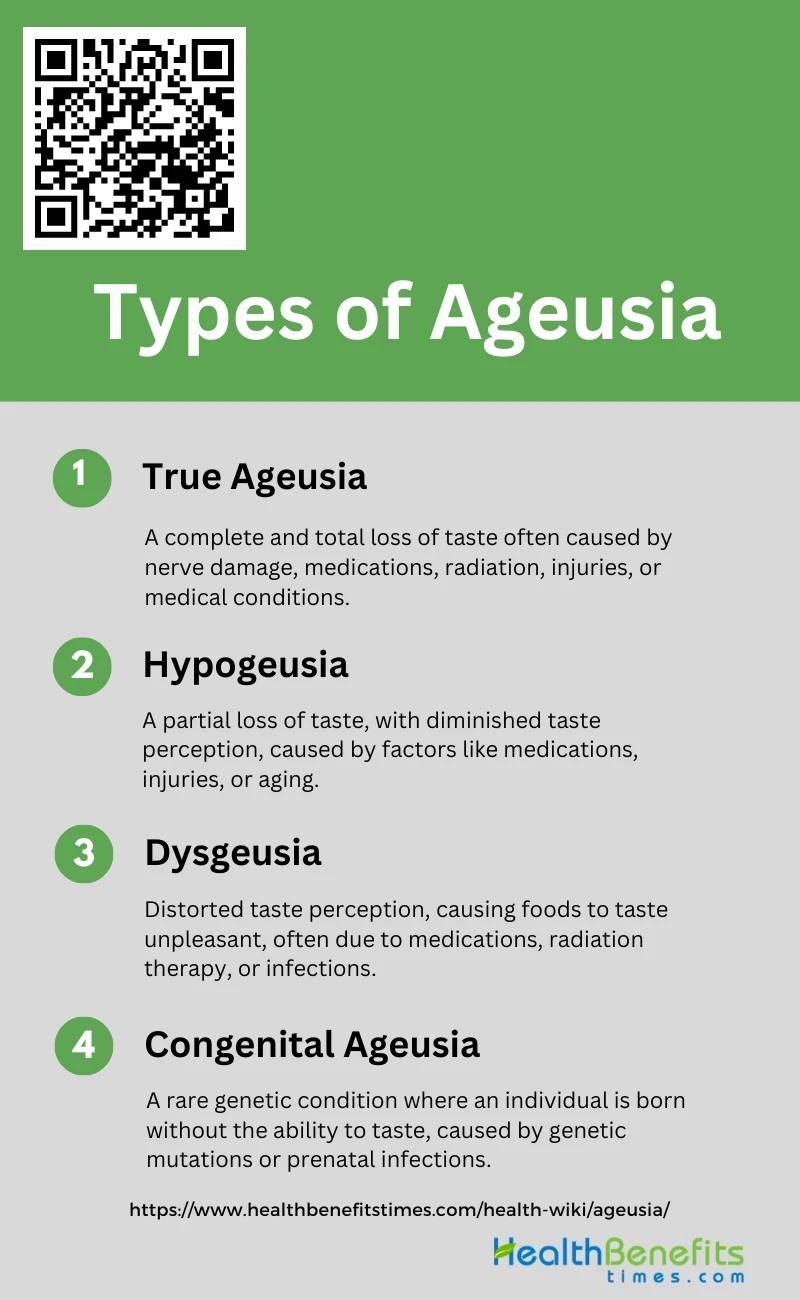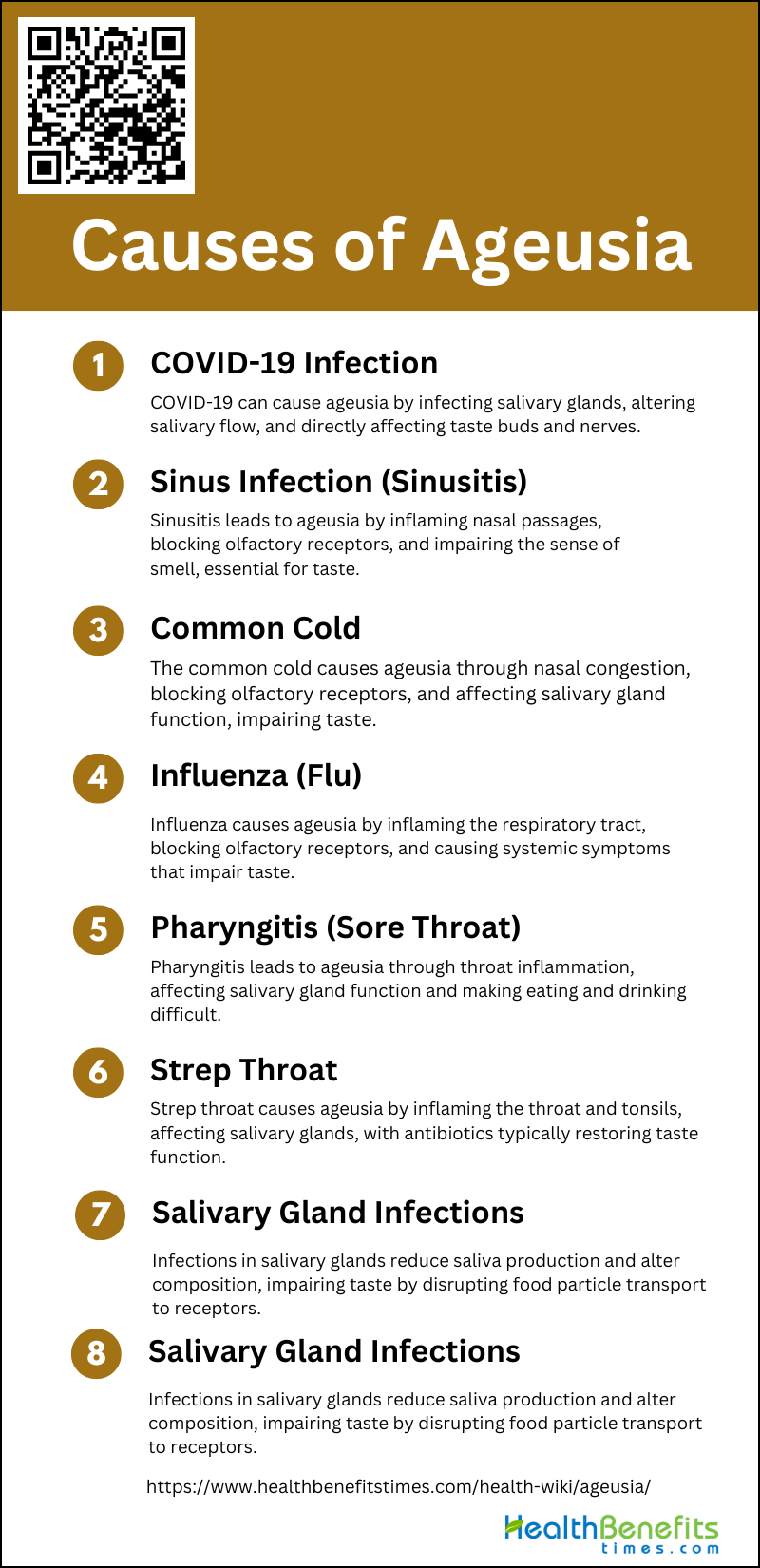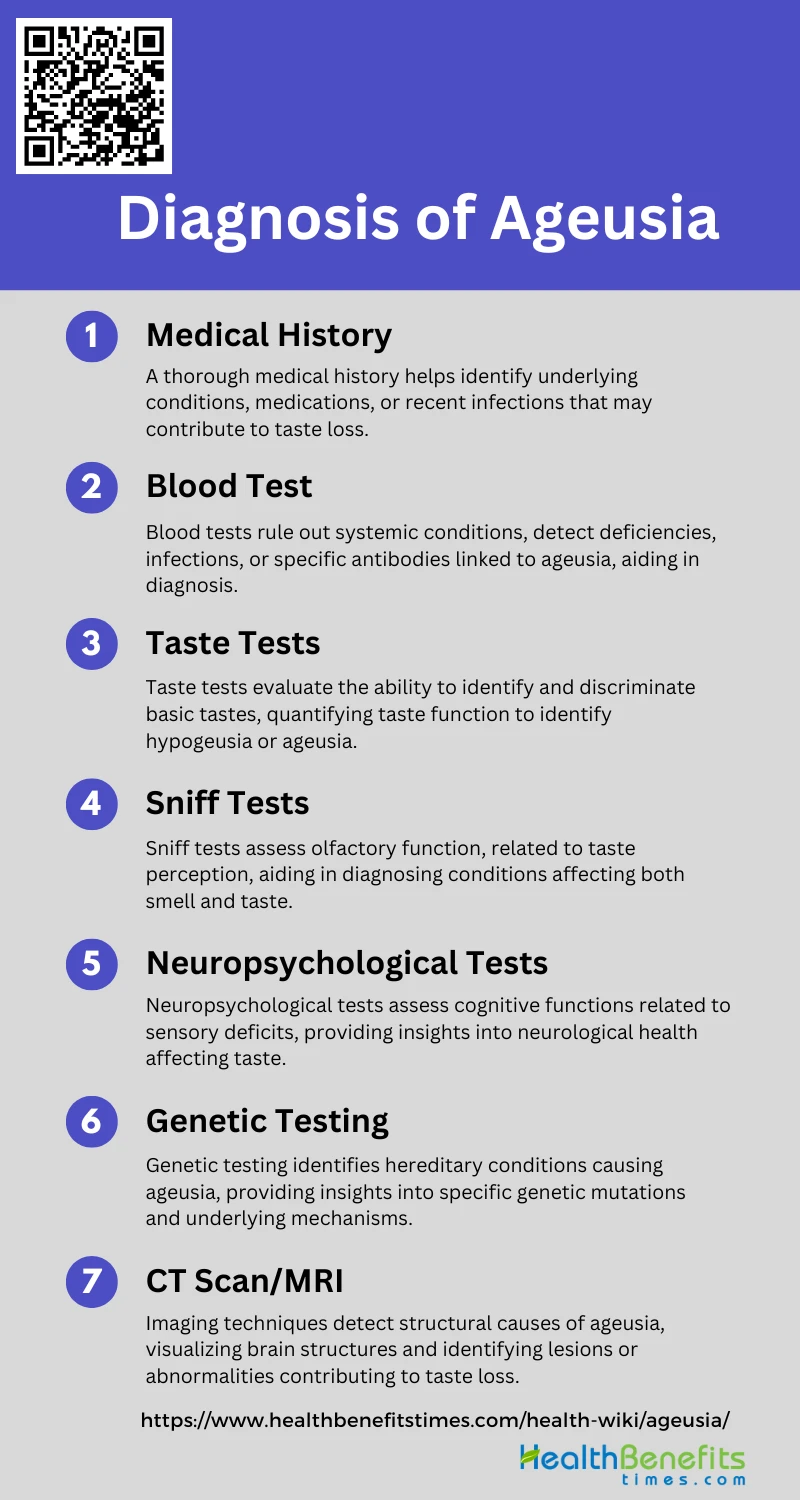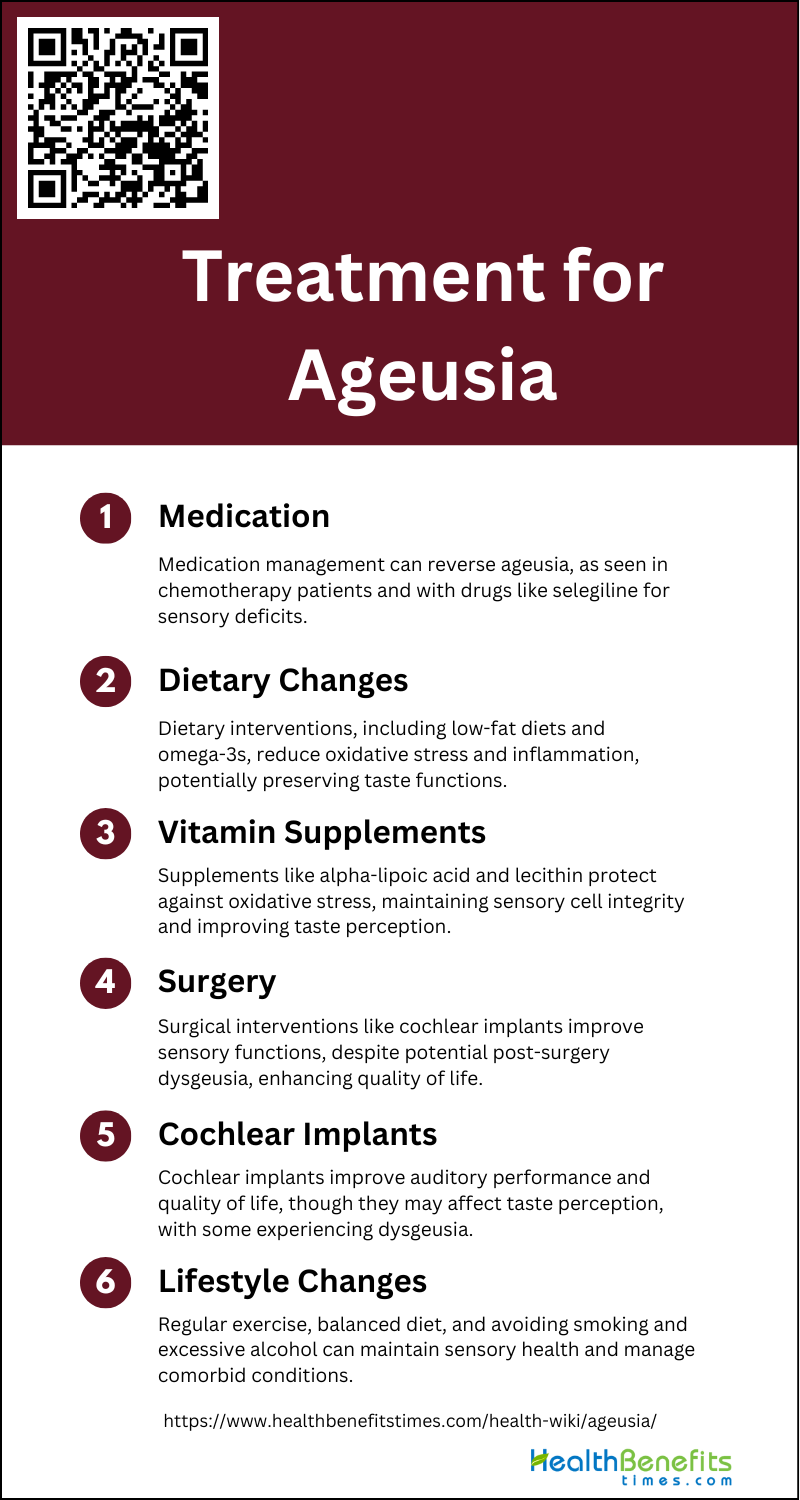 Ageusia is the complete loss of taste function of the tongue, characterized by the inability to detect sweetness, sourness, bitterness, saltiness, and umami (savory taste). It is a rare condition that differs from hypogeusia (decreased taste sensitivity) and dysgeusia (distorted or altered taste perception). Ageusia can arise from various factors such as damage to the taste nerves (lingual and glossopharyngeal nerves), dietary deficiencies, systemic conditions like hypothyroidism, diabetes mellitus, Sjögren’s syndrome, and Crohn’s disease, as well as certain medications, radiation therapy, and head or neck injuries.
Ageusia is the complete loss of taste function of the tongue, characterized by the inability to detect sweetness, sourness, bitterness, saltiness, and umami (savory taste). It is a rare condition that differs from hypogeusia (decreased taste sensitivity) and dysgeusia (distorted or altered taste perception). Ageusia can arise from various factors such as damage to the taste nerves (lingual and glossopharyngeal nerves), dietary deficiencies, systemic conditions like hypothyroidism, diabetes mellitus, Sjögren’s syndrome, and Crohn’s disease, as well as certain medications, radiation therapy, and head or neck injuries.
Types of Ageusia
There are several types of ageusia (loss of taste) and related taste disorders:
1. True Ageusia
It is relatively rare compared to other taste disorders. True ageusia can be caused by damage to the taste nerves, certain medications, radiation therapy, head injuries, or underlying medical conditions like diabetes or Sjogren’s syndrome.
2. Hypogeusia
Hypogeusia refers to a decreased or diminished sense of taste. It is a partial, rather than complete, loss of taste perception. Hypogeusia can result from many of the same causes as true ageusia, such as medications, head injuries, or aging.
3. Dysgeusia
Dysgeusia is a distorted or altered sense of taste, where flavors are perceived differently than normal. Dysgeusia can cause foods to taste metallic, salty, rancid, or otherwise unpleasant. It can be caused by certain medications, radiation therapy, or oral infections.
4. Congenital Ageusia
Congenital Ageusia is a rare inherited condition where an individual is born without the ability to taste. It is caused by genetic mutations or certain infections during pregnancy that affect the development of taste buds and nerves. Congenital ageusia is permanent and present from birth.
Causes of Ageusia
Below, we explore the numerous factors that can lead to the onset of ageusia.
1. COVID-19 Infection
COVID-19 infection has been widely associated with ageusia, or loss of taste. The virus, SARS-CoV-2, can cause significant changes in salivary composition, which is crucial for taste sensation. Studies have shown that the virus can infect and inflame salivary glands, leading to alterations in salivary flow and content, which in turn affects taste perception. Additionally, the virus may directly invade gustatory nerves or cause cytotoxicity to taste buds, contributing to ageusia. Reports indicate that taste disturbances are common early symptoms of COVID-19, often occurring within 2-3 days of clinical onset and can persist for weeks in some patients.
2. Sinus Infection (Sinusitis)
Sinus infections, or sinusitis, can lead to ageusia due to the inflammation and congestion of the nasal passages. This inflammation can block the olfactory receptors, which are closely linked to taste perception. The blockage and subsequent reduction in airflow to the olfactory epithelium can impair the sense of smell, which is essential for the full experience of taste. Although specific studies on sinusitis and ageusia are limited, the general understanding of the interconnectedness of smell and taste suggests that sinus infections can significantly impact taste perception.
3. Common Cold
The common cold, caused by various viruses, can lead to ageusia primarily through nasal congestion and inflammation. The congestion can block the olfactory receptors, reducing the sense of smell, which is crucial for taste. Additionally, the inflammation of the mucous membranes can affect the salivary glands and their secretions, further impairing taste sensation. While the common cold is generally mild, its impact on the olfactory system can temporarily diminish the sense of taste.
4. Influenza (Flu)
Influenza, commonly known as the flu, can cause ageusia through similar mechanisms as the common cold. The viral infection leads to inflammation of the respiratory tract, including the nasal passages and throat, which can block olfactory receptors and reduce the sense of smell. Additionally, the flu can cause systemic symptoms such as fever and fatigue, which can further impair taste perception. The impact on taste is usually temporary and resolves as the infection clears.
5. Pharyngitis (Sore Throat)
Pharyngitis, or sore throat, can lead to ageusia due to the inflammation and swelling of the throat and surrounding tissues. This inflammation can affect the salivary glands and their secretions, which are essential for taste. Additionally, the pain and discomfort associated with pharyngitis can make it difficult to eat and drink, further impairing taste perception. While pharyngitis is usually caused by viral or bacterial infections, its impact on taste is generally temporary and resolves with treatment.
6. Strep Throat
Strep throat, a bacterial infection caused by Streptococcus pyogenes, can lead to ageusia through inflammation and swelling of the throat and tonsils. This inflammation can affect the salivary glands and their secretions, which are crucial for taste. Additionally, the pain and discomfort associated with strep throat can make it difficult to eat and drink, further impairing taste perception. Antibiotic treatment is usually effective in resolving the infection and restoring normal taste function.
7. Salivary Gland Infections
Infections of the salivary glands, such as sialadenitis, can lead to ageusia by directly affecting the production and composition of saliva. Saliva is essential for taste as it helps dissolve food particles and transport them to taste receptors. Infections can cause inflammation and swelling of the salivary glands, reducing saliva production and altering its composition, which can impair taste sensation. These infections can be caused by bacteria or viruses and usually require medical treatment to resolve.
8. Allergies
Allergies can lead to ageusia through inflammation and congestion of the nasal passages and throat. Allergic reactions can cause swelling and blockage of the olfactory receptors, reducing the sense of smell, which is essential for taste. Additionally, allergies can cause postnasal drip and throat irritation, further impairing taste perception. Antihistamines and other allergy treatments can help alleviate these symptoms and restore normal taste function.
Sign and symptoms of Ageusia
Ageusia, the loss of taste functions of the tongue, can be a perplexing and often overlooked condition. It can significantly impact one’s enjoyment of food and, by extension, quality of life. Below is a list of common signs and symptoms associated with ageusia:
- Loss of ability to taste
- Inability to detect sweet, sour, salty, bitter and umami tastes
- Reduced appetite
- Difficulty distinguishing between food flavors
- Decreased interest in eating
Diagnosis of Ageusia
The diagnosis of ageusia is a nuanced process that requires careful evaluation. Medical professionals employ a combination of clinical assessments and diagnostic tests to accurately identify this sensory impairment. Following the initial evaluation, several key steps are taken to determine the underlying cause and appropriate treatment plan.
1. Medical History
A comprehensive medical history is crucial in diagnosing ageusia, as it helps identify underlying conditions that may contribute to the loss of taste. For instance, ageusia can be associated with neurological disorders such as Parkinson’s disease (PD) and multiple sclerosis (MS). Additionally, familial dysautonomia and neuromyelitis optica spectrum disorder (NMOSD) have also been linked to ageusia. Understanding the patient’s medical history, including any chronic illnesses, medications, and recent infections, can provide valuable insights into potential causes of ageusia.
2. Blood Test
Blood tests are essential in diagnosing ageusia as they help rule out systemic conditions that might affect taste. For example, a complete blood count (CBC) and metabolic panel can identify deficiencies or imbalances that could contribute to taste loss. In some cases, specific antibodies, such as the aquaporin 4 antibody in NMOSD, can be detected through blood tests, aiding in the diagnosis. Additionally, blood tests can help identify infections or inflammatory conditions that might be responsible for ageusia in COVID-19 patients.
3. Taste Tests
Taste tests are a direct method to evaluate the extent and nature of taste loss. These tests typically involve assessing the patient’s ability to identify and discriminate between the five basic tastes: salty, sweet, bitter, sour, and umami. For instance, specific tests have been developed to identify individuals who cannot taste monosodium L-glutamate (MSG), indicating a specific type of ageusia. Psychophysical taste tests, such as the “taste strips” and suprathreshold taste solutions, are commonly used to quantify taste function and identify hypogeusia or ageusia.
4. Sniff Tests
Sniff tests are used to evaluate olfactory function, which is often related to taste perception. In conditions like Parkinson’s disease and COVID-19, anosmia (loss of smell) frequently accompanies ageusia. Tests such as the Sniffin’ Sticks Test can help determine the extent of olfactory dysfunction. Evaluating both smell and taste can provide a more comprehensive understanding of the sensory deficits and aid in diagnosing conditions that affect both senses.
5. Neuropsychological Tests
Neuropsychological tests assess cognitive functions that may be related to sensory deficits. In Parkinson’s disease, olfactory loss is strongly tied to cognitive status, suggesting a link between cognitive decline and sensory dysfunction. Tests such as the Animal Fluency Test and Clock Drawing Test can help evaluate cognitive impairment, which may be associated with ageusia in conditions like multiple sclerosis. These tests provide a broader understanding of the patient’s neurological health and its impact on sensory functions.
6. Genetic Testing
Genetic testing can identify hereditary conditions that may cause ageusia. For instance, familial dysautonomia, a genetic disorder, has been linked to ageusia despite the presence of taste buds. Identifying genetic mutations can help diagnose specific types of ageusia and provide insights into the underlying mechanisms. Genetic testing is particularly useful in cases where ageusia is suspected to be part of a broader genetic syndrome.
7. CT Scan/MRI
CT scans and MRIs are critical in identifying structural causes of ageusia. For example, MRI can detect thalamic plaques in multiple sclerosis patients, which are associated with ageusia. MRI has been used to investigate central nervous system involvement, although no neuroinvasive evidence was found in the late stages. These imaging techniques help visualize brain structures and identify lesions or abnormalities that may contribute to taste loss, providing essential information for accurate diagnosis and treatment planning.
Complications of Ageusia
Below is a list of potential complications that individuals with ageusia may experience:
1. Poor Nutrition
Ageusia, the loss of taste, can significantly impact nutritional intake. Individuals with ageusia often experience a reduced appetite and altered eating habits, leading to poor nutrition. For instance, a study on older adults in assisted living facilities found that those with swallowing difficulties, often associated with ageusia, were more likely to be malnourished compared to those without such difficulties. Additionally, patients undergoing chemotherapy who developed ageusia reported significant weight loss and nutritional deficiencies, highlighting the critical role of taste in maintaining adequate nutrition. Therefore, ageusia can lead to poor nutrition, exacerbating health issues, especially in vulnerable populations.
2. Social Isolation
The social aspect of eating is profoundly affected by ageusia. The enjoyment of food is a common social activity, and the loss of taste can diminish the pleasure derived from shared meals, leading to social withdrawal. This is particularly evident in older adults who may already be at risk of social isolation. The inability to enjoy food can make social gatherings less appealing, contributing to feelings of loneliness and isolation. Research has shown that sensory impairments, including ageusia, can negatively impact social interactions and overall quality of life. Thus, ageusia not only affects physical health but also has significant social and psychological repercussions.
3. Loss of Pleasure
The loss of taste can lead to a significant reduction in the pleasure associated with eating. This can result in a decreased interest in food and eating, which can further contribute to poor nutrition and weight loss. For example, patients who developed ageusia after chemotherapy reported severe depression and a lack of enjoyment in eating, which affected their overall well-being. Similarly, individuals with ageusia due to COVID-19 experienced a prolonged loss of taste, which impacted their daily lives and reduced their overall quality of life. The loss of pleasure from eating is a significant complication of ageusia, affecting both mental and physical health.
4. Difficulty Swallowing
The sensory feedback from taste plays a crucial role in the swallowing process. A study highlighted that anosmia and ageusia in COVID-19 patients could negatively affect swallowing rehabilitation, as taste and smell are integral to the multisensory process of swallowing. Additionally, older adults with swallowing difficulties often consume modified food textures, which can further limit their food choices and nutritional intake. Therefore, ageusia can complicate swallowing, leading to further health issues such as malnutrition and aspiration.
5. Increased Risk for Choking
The loss of taste can increase the risk of choking, particularly in older adults. Age-related changes in the eating and swallowing system, combined with ageusia, can lead to a higher choking risk. For instance, older adults with poor dental status and reduced muscle strength in the swallowing system are at a significantly higher risk of choking on food. The absence of taste can also reduce the sensory cues that help in the safe swallowing of food, further increasing the risk. Therefore, ageusia can contribute to an increased risk of choking, necessitating careful management and monitoring, especially in elderly populations.
Treatment and Management for Ageusia
Below is a list of potential treatments and management options for those experiencing ageusia.
1. Medication
Medications can play a crucial role in the treatment of ageusia, particularly when the condition is a side effect of other treatments. For instance, a case study reported reversible ageusia in a patient undergoing chemotherapy with pegylated liposomal doxorubicin. The patient’s sense of taste returned to normal after switching to conventional doxorubicin, highlighting the importance of medication management in treating ageusia. Additionally, selegiline, an antiparkinsonian drug, has shown promise in mitigating age-related sensory deficits due to its neuroprotective and antioxidant properties.
2. Dietary Changes
Dietary interventions can be beneficial in managing ageusia, especially when the condition is linked to nutritional deficiencies or metabolic disorders. Nutritional interventions, such as a low-fat diet and the inclusion of omega-3 polyunsaturated fatty acids, have been shown to reduce oxidative stress and inflammation, which can help preserve sensory functions. Additionally, incorporating foods rich in antioxidants like tea and ginseng may offer protective effects against sensory deficits, including ageusia.
3. Vitamin Supplements
Vitamin supplements can be an effective strategy for managing ageusia, particularly when the condition is associated with deficiencies. Supplements such as alpha-lipoic acid and lecithin have been found to protect against oxidative stress and mitochondrial damage, which are common in age-related sensory impairments. These supplements can help maintain the integrity of sensory cells, potentially improving taste perception in individuals with ageusia.
4. Surgery
Surgical interventions, such as cochlear implantation, have been primarily used for hearing loss but can also impact taste perception. Studies have shown that cochlear implantation in elderly patients can lead to improved quality of life and auditory performance, although some patients may experience complications like dysgeusia post-surgery. Despite these risks, the overall benefits of cochlear implants in sensory rehabilitation are significant, making surgery a viable option for some patients.
5. Cochlear Implants
Cochlear implants are a well-established treatment for profound hearing loss and have been shown to improve quality of life and auditory performance in elderly patients. While primarily used for hearing rehabilitation, cochlear implants can also affect taste perception, with some patients experiencing dysgeusia post-implantation1. Despite these complications, the overall benefits of cochlear implants in enhancing sensory functions make them a valuable treatment option.
6. Lifestyle Changes
Lifestyle changes can significantly impact the management of ageusia. Regular physical activity, a balanced diet, and avoiding smoking and excessive alcohol consumption can help maintain overall sensory health. Additionally, managing comorbid conditions such as obesity and metabolic syndrome through lifestyle modifications can reduce the risk of sensory deficits, including ageusia. These changes can help improve the quality of life and sensory functions in individuals with ageusia.






